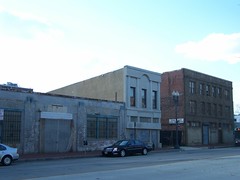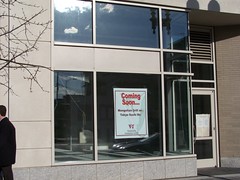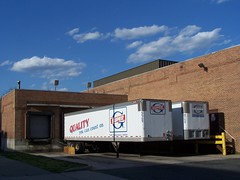If you don't understand linkage and context then you have learned nothing

1200 block 9th Street NW, west side. How can visitors to Washington's Convention Center not feel welcomed by this block?
In the cartoon "The Secret of NIMH," about rats who have gained intelligence from being test subjects at the Nat. Institute 0f Mental Health, there is a battle between two rats vying for leadership. The "bad" rat's philosophy was "Take what you can when you can." And in reply, said the other rat, drawing his sword, "Then you have learned nothing."
I feel that way a lot in conversations (and reading newspaper stories) about urban revitalization. Being a-historical means people learn nothing, keep doing the same things, yet expecting a different result.
The interesting thing about today's Post articles about the Washington Convention Center, "Convention Center Not Living Up to Lofty Goals," subtitled "Declining Attendance Limits Economic Impact," and "Ninth Street Corridor Still Awaits Renaissance," was that before the Center was built, the Post ran little criticism, until the day it opened when the articles on the front page of the Post business section did offer some critical analysis. (You know the phrase, "a day late and a dollar short...")
The point of criticism is to bring about success.
Too often, people focus on being criticized and not the message.
Anyway, re: "Ninth Street Corridor Still Awaits Renaissance," subtitled "Ninth Street Corridor Denizens Baffled by Lack of Development," I wrote about this extensively last year, making the point that money, from $10 million to $15 million, should have been invested simultaneously in improving the 9th Street NW corridor, from M Street to Rhode Island Avenue. Click here for block by block photos of this stretch.
No one will walk outside of the Convention Center to patronize businesses there, because most of the street is bombed out. And the retail that is in the Convention Center, such as the new Old Dominion Brewpub, will further keep people within the Convention Center.
Why isn't this obvious? If you don't link and connect the new to the extant, you're going to get little impact. In fact, the development in the Gallery Place/East End area is a perfect example. Only until more "destinations" developed around the MCI Center (now Verizon) did the area become reborn as an exciting district and destination. While I have problems with the level of authenticity (Starbucks, chain retail, Hooters, etc.), there is no question that there is activity. Even though most of the retail within the Verizon Center continues to fail. It is the retail and destinations outside of the Verizon Center, especially the reopened Smithsonian American Art Museum and National Portrait Gallery, that are really driving the area now. Plus the theaters of course, restaurants, etc.
One of the real problems in doing economic impact studies is that they are projections based on some rules of thumb, but the rules aren't nuanced enough. That's a problem.
From the Hedgpeth article:
The World Philatelic Exhibition, in fact, was the largest event last year, but, like the auto show, it brought fewer overnight visitors who feed the economy with money that wouldn't otherwise have been spent in the area.
The stamp show drew 80,000 visitors to see the first U.S. stamps, among other attractions. Convention center officials calculate that the show generated $83 million in spending, one-fifth of the $405 million that they say all conventioneers brought to the city last year. They got that number by multiplying the number of attendees by the industry standard of $1,039, which includes spending on a hotel, food, taxis and shopping. But critics say not everyone spends that much, especially those on a one-day trip. In any event, the 2006 level was below the kind of spending that was promised when the convention center was planned. Then, spending of $522 million in 2006 was projected.
1. The multiplier needs to be weighted, with a different calculation for those who stay overnight, vs. those who don't.
For example, the economic multiplier I use for arts patrons is something like $21.50, which is the amount that patrons spend in addition to tickets, if they are in-region. E.g., there's no way people who see plays at the H Street Playhouse or the Atlas Performing Arts Center are visiting from out-of-town and staying overnight. (This number is based on a study done by Arts & Economic Prosperity: The Economic Impact of Nonprofit Arts Organizations and Their Audiences.)
So my number ends up being a lot more realistic.
2. One of the problems with the economic impact numbers is that they are driven by hotel rooming nights. I am not privy to the operating numbers for a hotel, but most of the money spent on a hotel stay goes to the property owner--usually out of town. Only a little of the money is spent locally, mostly on personnel (front desk and housekeeping). Labor value stays local and recirculates. Rooming revenue repatriated to some Real Estate Investment Trust does not.
In other words, the numbers need to be recalculated to take into account how much of the total spent stays local and how much is repatriated elsewhere. For example, a study comparing locally-owned retail to chain oriented retail found that 54 cents of a dollar spent in a locally owned store recirculated locally, while 86 cents of a dollar spent in a chain owned store left the region.
Don Rypkema, a real estate consultant, says that the economic impact of big projects such as Convention Centers and stadiums and arenas is about 1.5 blocks...
3. Relatedly, in terms of economic impact of office workers is the point I make repeatedly about how office workers eachj support 2 s.f. of retail and 5 s.f. of restaurant space. It takes thousands and thousands of workers to make "great" retail, especially because their day to day interest in retail is in convenience goods (sundries) not a broader variety of choice items.
Here is a link to Professor Haywood Sanders' paper published by the Brookings Institution: Space Available: The Realities of Convention Centers as Economic Development Strategy.

1200 block 9th Street NW, east side (Convention Center)
That being said, some decent retail and restaurants are starting to develop on the street, but more at the other end (towards Rhode Island and U Street).
And to get a sense of how traditional urban renewal doesn't really improve areas, check out the low dense housing on 7th Street NW, and the 9th and O Street Giant Supermarket.

The Giant Supermarket building design treats 9th Street NW as the "rear" of the market, with a loading dock and blank wall for an entire block.
Labels: retail, urban design/placemaking, urban revitalization



0 Comments:
Post a Comment
<< Home